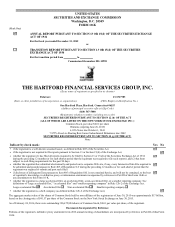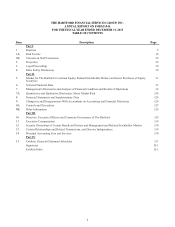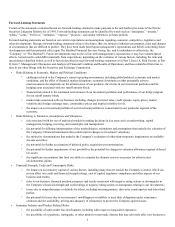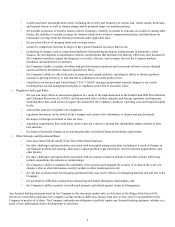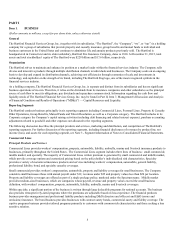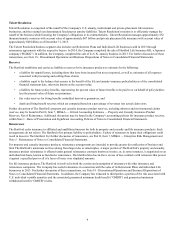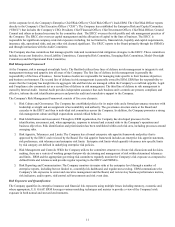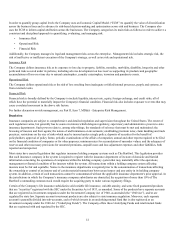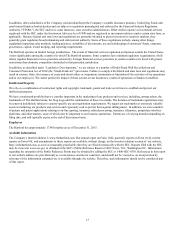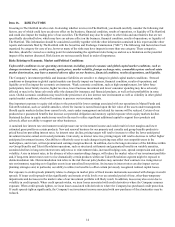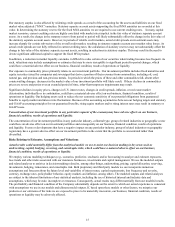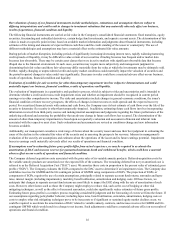The Hartford 2015 Annual Report Download - page 6
Download and view the complete annual report
Please find page 6 of the 2015 The Hartford annual report below. You can navigate through the pages in the report by either clicking on the pages listed below, or by using the keyword search tool below to find specific information within the annual report.6
Marketing and Distribution
Commercial Lines provide insurance products and services through the Company’s domestic offices and insurance centers. The products
are marketed nationally utilizing independent agents, brokers and wholesalers. The independent agent and broker distribution channel is
consolidating and this trend is expected to continue. This will likely result in a larger proportion of written premium being concentrated
among fewer agents and brokers. In addition, the Company offers insurance products to customers of payroll service providers through
its relationships with major national payroll companies and to members of affinity organizations.
Competition
In small commercial, The Hartford competes against large national carriers, as well as regional carriers in certain territories. Competitors
include stock companies, mutual companies and other underwriting organizations. The small commercial market is competitive as
carriers seek to differentiate themselves through product expansion, price reduction, enhanced service and cutting-edge technology.
Larger carriers such as The Hartford have improved their pricing sophistication and ease of doing business with agents and customers
through the use of technology, analytics and other capabilities that improve the process of evaluating a risk, quoting new business and
servicing customers. The Company is also adding to its digital capabilities as customers and distributors demand more access and
convenience, and expanding product and underwriting capabilities to accommodate both larger accounts and a broader risk appetite.
Written premium growth rates have been low for the insurance industry in the small commercial market due to weak economic
conditions. This has put pressure on underwriting margins as competitors seek new business by increasing their underwriting appetite,
and deepening their relationships with distribution partners. Also, carriers serving middle market-sized accounts are more aggressively
competing for small commercial accounts, which are generally less price-sensitive.
Middle market business is considered “high touch” and involves individualized underwriting and pricing decisions. The pricing of
middle market accounts is prone to significant variation or cyclicality over time due to changes in individual account characteristics and
exposure, as well as legislative and macro-economic forces. In addition, various state legislative reforms in recent years designed to
control workers compensation indemnity costs have led to rate reductions in many states. These factors, characterized by highly
competitive pricing on new business, have resulted in more customers shopping their policies for a lower price. In the face of this
competitive environment, The Hartford is working to deepen its product and underwriting capabilities, and leverage its sales and
underwriting talent with tools it has introduced in recent years. Through advanced training and analytics, the Company’s field
underwriters are working to improve risk selection and pricing decisions. In product development, and related areas such as claims and
risk engineering, the Company is extending its capabilities in industry verticals, such as construction, auto parts manufacturing and
hospitality. The Company has also added new middle market underwriters into the Midwest and Western U.S. to deepen relationships
with its distribution partners.
Specialty competes on an account- by-account basis due to the complex nature of each transaction. Competition in this market includes
stock companies, mutual companies, alternative risk sharing groups and other underwriting organizations. The Hartford’s relatively large
size and underwriting capacity is a competitive advantage over smaller insurance companies.
For specialty casualty businesses, written pricing competition continues to be significant, particularly for the larger individual accounts.
Carriers are aggressively negotiating renewals with customers by initiating the process in advance of the policy renewal date to improve
retention and reduce new business opportunities for competitors. As written pricing increases, more insureds may opt for the loss-
sensitive products offered in our national accounts segment, including retrospectively rated contracts, in lieu of guaranteed cost policies.
Within national accounts, the Company is planning to introduce a new risk management platform, allowing customers better access to
claim data and other information needed by corporate risk managers. This investment will allow the Company to work more closely with
customers to improve long-term account performance.
In the bond business, favorable underwriting results in recent years have led to increased competition for market share, setting the stage
for potential written price decreases. Public construction project work has slowed, resulting in only modest growth for Contract Surety
business.
In professional liability, large and medium-sized businesses are in differing competitive environments. Large public D&O, specifically
excess layers, is under significant competitive price pressure. The middle market private management liability segment is in a more
stable competitive and pricing environment.

